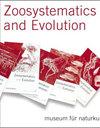Two new species of the congrid eel genus Ariosoma (Anguilliformes, Congridae, Bathymyrinae) from Indian waters
IF 1.6
2区 生物学
Q2 ZOOLOGY
引用次数: 0
Abstract
Two new species have been described from Indian waters, based on the materials collected from Kochi coast, Arabian Sea, Gulf of Mannar and West Bengal coast along the Bay of Bengal. Ariosoma gracilesp. nov. is described, based on five specimens collected from the landings at Kalamukku Fishing Harbour, Arabian Sea. The new species is characterised by longer tail, 55.3–58.7% TL; dorsal-fin origin above pectoral-fin base; no dark or whitish bands on dorsal surface of head, ventral extremities of lower jaw and mid-portion with minute dark pigmentation patch; anus positioned well before the middle of total length; SO canal with 4 pores; 0 or 3 pores on ST canal; pre-dorsal vertebrae 9; pre-anal vertebrae 49–54; total vertebrae 140–142. Ariosoma gracilesp. nov. is closely related to Ariosoma dolichopterum and Ariosoma emmae by sharing similar morphometrics and pre-anal vertebral counts. However, it differs by having more total pores (132–135 vs. 121–129 in A. dolichopterum, 123–126 in A. emmae); fewer pre-anal pores (43–46 vs. 47–51 in A. dolichopterum, 50–53 in A. emmae); more pre-dorsal pores (9 vs. 5–9 in A. dolichopterum, 4–6 in A. emmae). Another new species, Ariosoma kannanisp. nov. is described on the basis of two specimens (157–171 mm TL) from Gulf of Mannar and one specimen (201 mm TL) collected from Shankarpur Fish Landing Centre, West Bengal. This species is similar to Ariosoma megalops, but readily differs by having smaller eyes, smaller interorbital distance and exhibits 10.8% genetic divergence from A. megalops from the Taiwan waters.印度水域鳗鲡属(鳗形目、鳗鲡科、鳗鲡属)的两个新物种
根据从高知海岸、阿拉伯海、马纳尔湾和孟加拉湾沿岸的西孟加拉海岸采集的材料,描述了印度水域的两个新物种。根据从阿拉伯海 Kalamukku 渔港采集的 5 个标本,描述了新种 Ariosoma gracilesp.。该新种的特征是尾部较长,总长度为 55.3-58.7%;背鳍起源于胸鳍基部上方;头部背面无深色或白色条带,下颌腹面末端和中段有微小的深色色斑;肛门位于全长中部之前;SO 管有 4 个气孔;ST 管上有 0 或 3 个气孔;前背椎骨 9;前肛椎骨 49-54;总椎骨 140-142。Ariosoma gracilesp.nov.与 Ariosoma dolichopterum 和 Ariosoma emmae 关系密切,具有相似的形态计量学特征和肛前椎骨数。然而,它的不同之处在于:总孔数更多(132-135 对多利蝶 A. 的 121-129,A. emmae 的 123-126);肛前孔数更少(43-46 对多利蝶 A. 的 47-51,A. emmae 的 50-53);背前孔数更多(9 对多利蝶 A. 的 5-9,A. emmae 的 4-6)。另一个新种,Ariosoma kannanisp.nov.,是根据从马纳尔湾采集的两个标本(157-171 mm TL)和从西孟加拉邦 Shankarpur 鱼类上岸中心采集的一个标本(201 mm TL)描述的。该物种与巨尾鲷相似,但眼睛较小,眶间距较小,与台湾水域的巨尾鲷有 10.8%的遗传差异。
本文章由计算机程序翻译,如有差异,请以英文原文为准。
求助全文
约1分钟内获得全文
求助全文
来源期刊

Zoosystematics and Evolution
ZOOLOGY-
CiteScore
3.50
自引率
5.00%
发文量
34
审稿时长
16 weeks
期刊介绍:
Zoosystematics and Evolution, formerly Mitteilungen aus dem Museum für Naturkunde in Berlin, is an international, open access, peer-reviewed life science journal devoted to whole-organism biology. It publishes original research and review articles in the field of Metazoan taxonomy, biosystematics, evolution, morphology, development and biogeography at all taxonomic levels. The journal''s scope encompasses primary information from collection-related research, taxonomic descriptions and discoveries, revisions, annotated type catalogues, aspects of the history of science, and contributions on new methods and principles of systematics. Articles whose main topic is ecology, functional anatomy, physiology, or ethology are only acceptable when of systematic or evolutionary relevance and perspective.
 求助内容:
求助内容: 应助结果提醒方式:
应助结果提醒方式:


